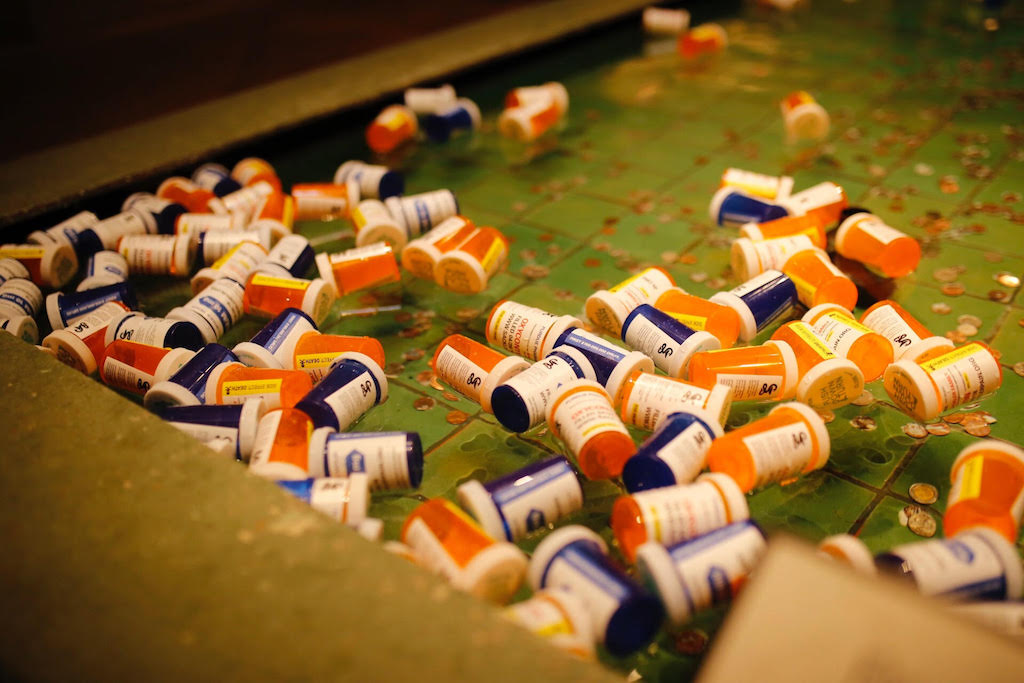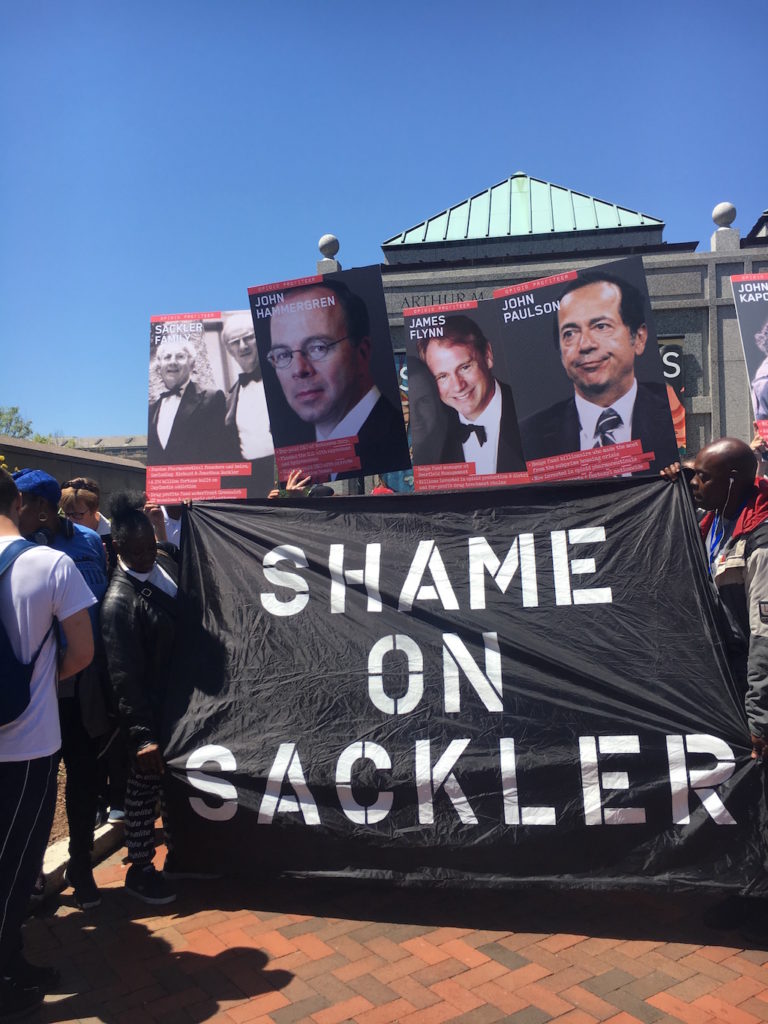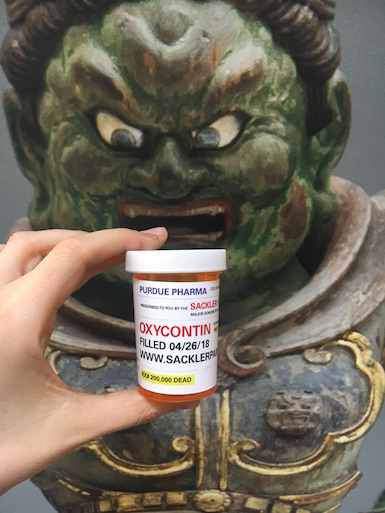[ad_1]

Pill bottles spilled in protest at the Arthur M. Sackler Gallery in Washington, D.C.
BOBBY COFFEY
At the entrance of a dharma-inspired exhibition at the Smithsonian Institution’s Arthur M. Sackler Gallery in Washington, D.C., a projection reads, “In Enlightenment there is no suffering.” Today, the artist Nan Goldin and her activist group known as Prescription Addiction Intervention Now, or P.A.I.N, showed up to hold the Sackler family to those words.
In its second big protest, after a first one at New York’s Metropolitan Museum of Art last month, P.A.I.N aimed to make members of the Sackler family direct their philanthropic energies toward ending the suffering and death that has attended the recent opioid epidemic in America. As a means to such an end, a tight-knit group of artists, recovery professionals, and harm-reduction activists staged a protest in the nation’s capital.

Nan Goldin outside the Arthur M. Sackler Gallery in Washington, D.C.
BOBBY COFFEY
Working with the Center for Popular Democracy, a nonprofit advocacy organization running a network of anti-opioid groups, Goldin brought dozens of protesters from across the country to disrupt a spectacularly serene day in the Smithsonian’s Asian art wing and outdoor garden. The activists, many in recovery themselves, organized around the carousel on the National Mall to share stories and statistics before marching into the gallery to fan out along the stairs and surround a small fountain filled with wish-aspiring coins.
Inside the gallery, with more than a little significance for some, was Reaching for the Moon, a suspended site-specific sculpture by the artist Xu Bing. With forms of interlocking monkeys pulling upward, the work seemed to represent the old notion of “getting a monkey off one’s back”—a 1930s-era phrase for attempting to kick heroin addiction. In the midst of that, protesters threw orange and blue pill bottles, labeled as Vicodin and OxyContin, into the fountain below. While the bottles floated over glistening coins, the group ran a call-and-response session about Sackler family history—chanting “shame on Sackler” and “addiction equals profits.”
Arthur M. Sackler’s widow, Jillian Sackler, has attempted to distance her husband and herself from previous protests and investigative articles exposing the connection between the family-affiliated drug company Purdue Pharma and Oxycontin, the main pain medication blamed for the current epidemic of opioid addiction that claimed more lives in 2016 than were lost during the Vietnam War, according to a report issued last year by the Police Executive Research Forum. In reaction to today’s protest, Jillian Sackler’s spokesperson said in a statement, “Arthur Sackler died nine years before OxyContin was introduced and had nothing to do with Purdue Pharma, and his family have not benefited from OxyContin profits.”

Signs outside the Arthur M. Sackler Gallery in Washington, D.C.
ANA FINEL HONIGMAN
P.A.I.N has rejected this argument and worked renewed opposition into speeches and chants today around the fountain and in the opulent flower garden outside. As Goldin and others argued, Arthur Sackler was a medical ad man whose marketing strategies promoted Valium, a central companion for OxyContin in Goldin’s own nearly fatal 17-year-long bout with addiction. With her ignited red hair and tiny frame, Goldin embodied the notion of a polemical “firecracker” while standing in front of a “shame on the Sacklers” sign and telling her story. As she explained, Arthur Sackler marketed Valium as a cure-all, thereby paving the way for the over-medication of physical and psychological pain in America. As the family patriarch, his influence cannot be separated from the branch of the family that now directly profits off OxyContin. “The Sackler brothers built an empire of pain on hundreds of thousands of people,” Goldin proclaimed. “For them, addiction equals profits.”

A would-be OxyContin bottle.
ANA FINEL HONIGMAN
As Goldin acknowledges, it is no accident that addiction and art are interconnected in the current epidemic. The mythic correspondence between addiction and creativity creates an illusory romance around artists’ self-destruction. While art collectors might profit from mythology surrounding such behavior, the Sackler family, in the estimation of protesters, uses art’s elevating glamour to disguise the predatory nature of their product-pushing. “I’ve felt addiction in my body,” Goldin said, “and now I am speaking for those who can’t speak anymore. For me, the personal is now political.”
Holding the Sackler family accountable is only part of P.A.I.N’s mission. The ultimate goal is not discrediting the lofty institutions of art and learning funded by the Sackler family in locales including Oxford University, Harvard, the Tate, and the Louvre. Instead, a better end in the group’s mind would be shaming the beneficiaries of what some compare to blood money into pouring their fortune into reparations.
Expanding beyond the Sackler family members themselves, today’s protest drew attention to OxyContin profiteers such as John Kapoor, the founder of an Arizona-based drug company responsible for a deadly oral fentanyl spray, and James Flynn of Deerfield Management, a hedge-fund currently backing opioid distributors and manufactures. “If you want to find the drug dealers,” said Michael Kink, executive director of the Strong Economy for All Coalition, “you’ll need to raid Greenwich, Connecticut.”
[ad_2]
Source link

